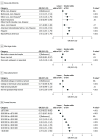Association of Socioeconomic, Demographic, and Health Care Access Disparities With Severe Visual Impairment in the US
- PMID: 36326732
- PMCID: PMC9634598
- DOI: 10.1001/jamaophthalmol.2022.4566
Association of Socioeconomic, Demographic, and Health Care Access Disparities With Severe Visual Impairment in the US
Abstract
Importance: Approximately 13% of US adults are affected by visual disability, with disproportionately higher rates in groups impacted by certain social determinants of health (SDOH).
Objective: To evaluate SDOH associated with severe visual impairment (SVI) to ultimately guide targeted interventions to improve ophthalmic health.
Design, setting, and participants: This quality improvement study used cross-sectional data from a telephone survey from the Behavioral Risk Factor Surveillance System (BRFSS) that was conducted in the US from January 2019 to December 2020. Participants were noninstitutionalized adult civilians who were randomly selected and interviewed and self-identified as "blind or having serious difficulty seeing, even while wearing glasses."
Exposures: Demographic and health care access factors.
Main outcomes and measures: The main outcome was risk of SVI associated with various factors as measured by odds ratios (ORs) and 95% CIs. Descriptive and logistic regression analyses were performed using the Web Enabled Analysis Tool in the BRFFS.
Results: During the study period, 820 226 people (53.07% female) participated in the BRFSS survey, of whom 42 412 (5.17%) self-identified as "blind or having serious difficulty seeing, even while wearing glasses." Compared with White, non-Hispanic individuals, risk of SVI was increased among American Indian/Alaska Native (OR, 1.63; 95% CI, 1.38-1.91), Black/African American (OR, 1.50; 95% CI, 1.39-1.62), Hispanic (OR, 1.65; 95% CI, 1.53-1.79), and multiracial (OR, 1.33; 95% CI, 1.15-1.53) individuals. Lower annual household income and educational level (eg, not completing high school) were associated with greater risk of SVI. Individuals who were out of work for 1 year or longer (OR, 1.78; 95% CI, 1.54-2.07) or who reported being unable to work (OR, 2.90; 95% CI, 2.66-3.16) had higher odds of SVI compared with the other variables studied. Mental health diagnoses and 14 or more days per month with poor mental health were associated with increased risk of SVI (OR, 1.87; 95% CI, 1.73-2.02). Health care access factors associated with increased visual impairment risk included lack of health care coverage and inability to afford to see a physician.
Conclusions and relevance: In this study, various SDOH were associated with SVI, including self-identification as being from a racial or ethnic minority group; low socioeconomic status and educational level; long-term unemployment and inability to work; divorced, separated, or widowed marital status; poor mental health; and lack of health care coverage. These disparities in care and barriers to health care access should guide targeted interventions.
Conflict of interest statement
Figures


Comment in
-
Considerations for Using Large Data Sets to Assess Disparities in Eye Care and Vision Health.JAMA Ophthalmol. 2022 Dec 1;140(12):1226-1228. doi: 10.1001/jamaophthalmol.2022.4601. JAMA Ophthalmol. 2022. PMID: 36326748 Free PMC article. No abstract available.
References
-
- Blewett LA, Rivera Drew JA, King ML, Williams KC. IPUMS health surveys: National Health Interview Survey. 6.4 ed. IPUMS NHIS database 2019. Accessed August 15, 2022. https://nhis.ipums.org/nhis/
-
- American Foundation for the Blind. Facts and figures on adults with vision loss. Updated September 2020. Accessed January 15, 2022. https://www.afb.org/research-and-initiatives/statistics/adults
-
- West SK, Munoz B, Rubin GS, et al. Function and visual impairment in a population-based study of older adults: the SEE project: Salisbury Eye Evaluation. Invest Ophthalmol Vis Sci. 1997;38(1):72-82. - PubMed

